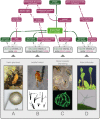Finding our way through phenotypes
- PMID: 25562316
- PMCID: PMC4285398
- DOI: 10.1371/journal.pbio.1002033
Finding our way through phenotypes
Abstract
Despite a large and multifaceted effort to understand the vast landscape of phenotypic data, their current form inhibits productive data analysis. The lack of a community-wide, consensus-based, human- and machine-interpretable language for describing phenotypes and their genomic and environmental contexts is perhaps the most pressing scientific bottleneck to integration across many key fields in biology, including genomics, systems biology, development, medicine, evolution, ecology, and systematics. Here we survey the current phenomics landscape, including data resources and handling, and the progress that has been made to accurately capture relevant data descriptions for phenotypes. We present an example of the kind of integration across domains that computable phenotypes would enable, and we call upon the broader biology community, publishers, and relevant funding agencies to support efforts to surmount today's data barriers and facilitate analytical reproducibility.
Conflict of interest statement
The authors have declared that no competing interests exist.
Figures


References
Publication types
MeSH terms
Grants and funding
LinkOut - more resources
Full Text Sources
Other Literature Sources
Miscellaneous

